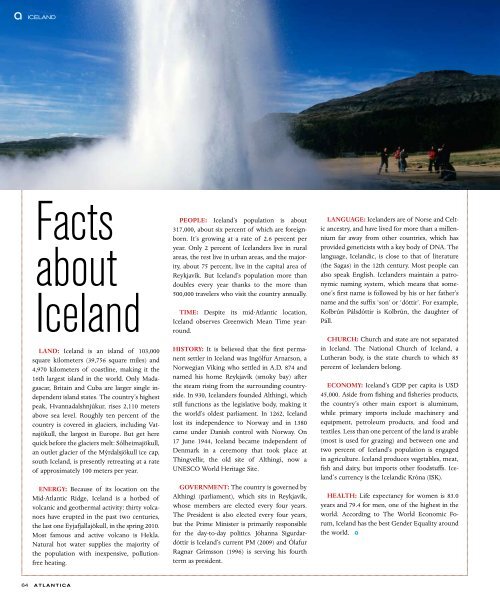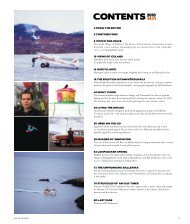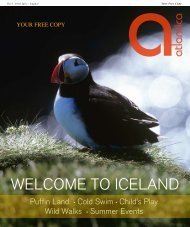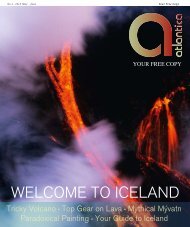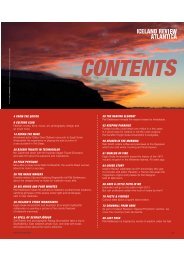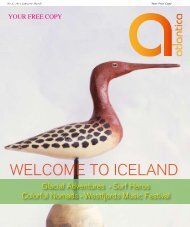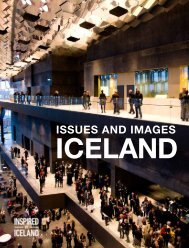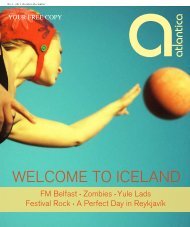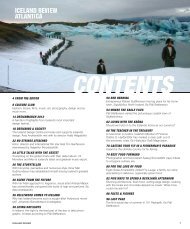Atlantica - Iceland Review
Atlantica - Iceland Review
Atlantica - Iceland Review
You also want an ePaper? Increase the reach of your titles
YUMPU automatically turns print PDFs into web optimized ePapers that Google loves.
a<br />
iceland<br />
Facts<br />
about<br />
<strong>Iceland</strong><br />
LAND: <strong>Iceland</strong> is an island of 103,000<br />
square kilometers (39,756 square miles) and<br />
4,970 kilometers of coastline, making it the<br />
16th largest island in the world. Only Madagascar,<br />
Britain and Cuba are larger single independent<br />
island states. The country’s highest<br />
peak, Hvannadalshnjúkur, rises 2,110 meters<br />
above sea level. Roughly ten percent of the<br />
country is covered in glaciers, including Vatnajökull,<br />
the largest in Europe. But get here<br />
quick before the glaciers melt: Sólheimajökull,<br />
an outlet glacier of the Mýrdalsjökull ice cap,<br />
south <strong>Iceland</strong>, is presently retreating at a rate<br />
of approximately 100 meters per year.<br />
ENERGY: Because of its location on the<br />
Mid-Atlantic Ridge, <strong>Iceland</strong> is a hotbed of<br />
volcanic and geothermal activity: thirty volcanoes<br />
have erupted in the past two centuries,<br />
the last one Eyjafjallajökull, in the spring 2010.<br />
Most famous and active volcano is Hekla.<br />
Natural hot water supplies the majority of<br />
the population with inexpensive, pollutionfree<br />
heating.<br />
PEOPLE: <strong>Iceland</strong>’s population is about<br />
317,000, about six percent of which are foreignborn.<br />
It’s growing at a rate of 2.6 percent per<br />
year. Only 2 percent of <strong>Iceland</strong>ers live in rural<br />
areas, the rest live in urban areas, and the majority,<br />
about 75 percent, live in the capital area of<br />
Reykjavík. But <strong>Iceland</strong>’s population more than<br />
doubles every year thanks to the more than<br />
500,000 travelers who visit the country annually.<br />
TIME: Despite its mid-Atlantic location,<br />
<strong>Iceland</strong> observes Greenwich Mean Time yearround.<br />
HISTORY: It is believed that the first permanent<br />
settler in <strong>Iceland</strong> was Ingólfur Arnarson, a<br />
Norwegian Viking who settled in A.D. 874 and<br />
named his home Reykjavík (smoky bay) after<br />
the steam rising from the surrounding countryside.<br />
In 930, <strong>Iceland</strong>ers founded Althingi, which<br />
still functions as the legislative body, making it<br />
the world’s oldest parliament. In 1262, <strong>Iceland</strong><br />
lost its independence to Norway and in 1380<br />
came under Danish control with Norway. On<br />
17 June 1944, <strong>Iceland</strong> became independent of<br />
Denmark in a ceremony that took place at<br />
Thingvellir, the old site of Althingi, now a<br />
UNESCO World Heritage Site.<br />
GOVERNMENT: The country is governed by<br />
Althingi (parliament), which sits in Reykjavík,<br />
whose members are elected every four years.<br />
The President is also elected every four years,<br />
but the Prime Minister is primarily responsible<br />
for the day-to-day politics. Jóhanna Sigurdardóttir<br />
is <strong>Iceland</strong>’s current PM (2009) and Ólafur<br />
Ragnar Grímsson (1996) is serving his fourth<br />
term as president.<br />
LANGUAGE: <strong>Iceland</strong>ers are of Norse and Celtic<br />
ancestry, and have lived for more than a millennium<br />
far away from other countries, which has<br />
provided geneticists with a key body of DNA. The<br />
language, <strong>Iceland</strong>ic, is close to that of literature<br />
(the Sagas) in the 12th century. Most people can<br />
also speak English. <strong>Iceland</strong>ers maintain a patronymic<br />
naming system, which means that someone’s<br />
first name is followed by his or her father’s<br />
name and the suffix ‘son’ or ‘dóttir’. For example,<br />
Kolbrún Pálsdóttir is Kolbrún, the daughter of<br />
Páll.<br />
CHURCH: Church and state are not separated<br />
in <strong>Iceland</strong>. The National Church of <strong>Iceland</strong>, a<br />
Lutheran body, is the state church to which 85<br />
percent of <strong>Iceland</strong>ers belong.<br />
ECONOMY: <strong>Iceland</strong>’s GDP per capita is USD<br />
45,000. Aside from fishing and fisheries products,<br />
the country’s other main export is aluminum,<br />
while primary imports include machinery and<br />
equipment, petroleum products, and food and<br />
textiles. Less than one percent of the land is arable<br />
(most is used for grazing) and between one and<br />
two percent of <strong>Iceland</strong>’s population is engaged<br />
in agriculture. <strong>Iceland</strong> produces vegetables, meat,<br />
fish and dairy, but imports other foodstuffs. <strong>Iceland</strong>’s<br />
currency is the <strong>Iceland</strong>ic Króna (ISK).<br />
HEALTH: Life expectancy for women is 83.0<br />
years and 79.4 for men, one of the highest in the<br />
world. According to The World Economic Forum,<br />
<strong>Iceland</strong> has the best Gender Equality around<br />
the world. a<br />
64 atlantica


